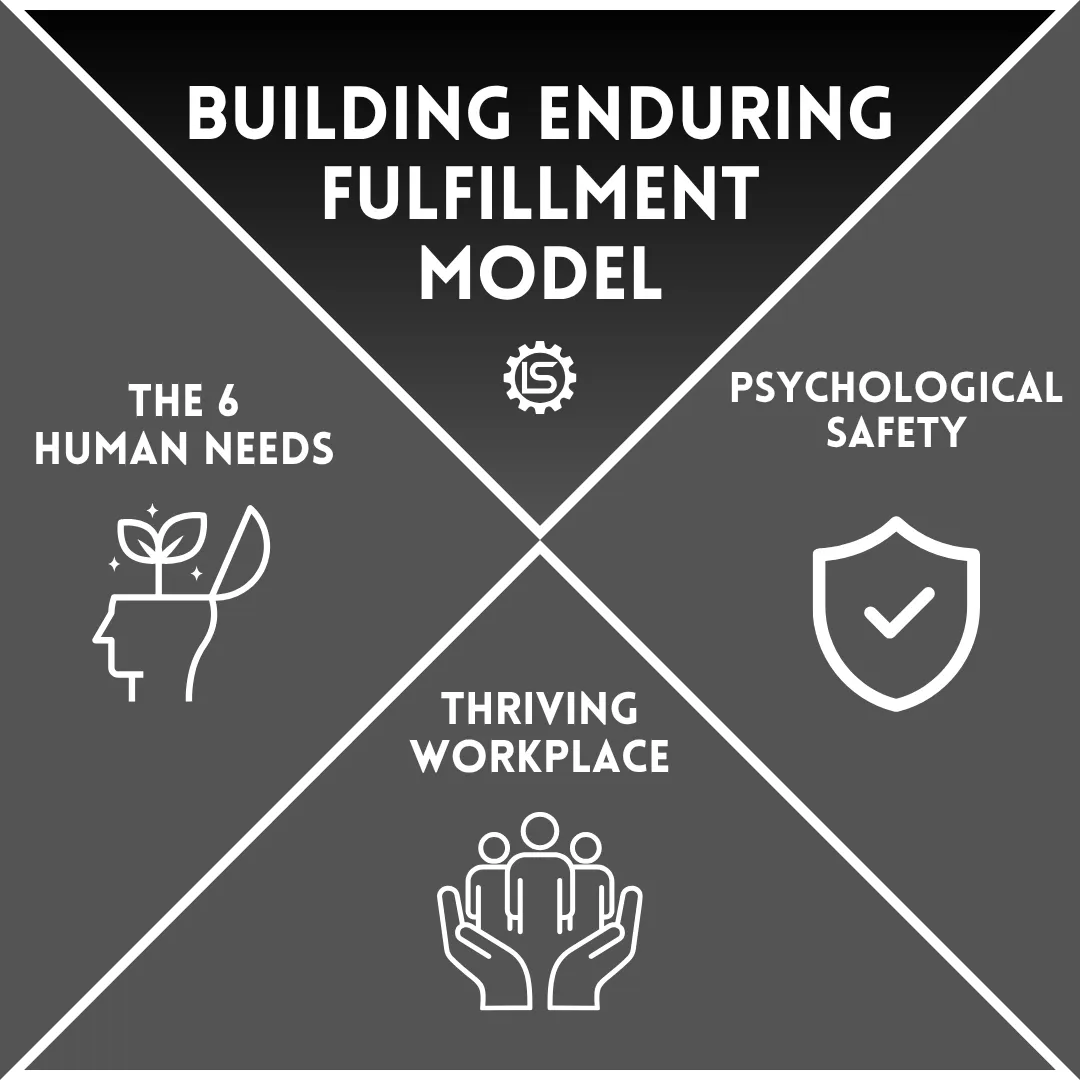
Building Enduring Fulfillment: The Foundation of a Thriving Workplace
Building Enduring Fulfillment: The Foundation of a Thriving Workplace
Imagine a workplace where people don’t just show up — they light up.
Where trust runs deep, innovation flows freely, and every team member feels valued and supported.
That’s not a fantasy — it’s the foundation of Building Enduring Fulfillment, the first phase of The Engagement Trilogy. Developed from more than 50 years of leadership and consulting experience with organizations like General Motors, GE Medical, and Colgate-Palmolive, this model outlines how to create a culture that fuels loyalty, performance, and purpose from the inside out.
In today’s workplace — where only 21% of employees are actively engaged (Gallup, 2025) — building fulfillment isn’t a “nice to have.” It’s an essential strategy for growth.
Let’s explore how this process works and why it transforms entire organizations.
Step 1: Establish Psychological Safety
Every successful culture begins with trust.
Psychological safety — a term introduced by Harvard’s Dr. Amy Edmondson — means employees feel free to share ideas, ask questions, and even admit mistakes without fear of embarrassment or punishment. It’s the foundation of innovation, teamwork, and engagement.
When people feel safe, they speak up. They experiment. They learn.
But when fear dominates, creativity disappears, collaboration breaks down, and disengagement spreads.
According to Gallup (2024), disengagement costs U.S. companies over $1.9 trillion annually in lost productivity. Psychological safety addresses that root cause. It’s not about making everyone comfortable — it’s about making it safe to take smart risks.
Here’s how organizations can start building it:
Model vulnerability: Leaders share lessons learned from past challenges to set the tone that openness is valued.
Host no-blame meetings: Frame mistakes as learning opportunities instead of failures.
Train for inclusion: Teach active listening and non-judgmental communication so every voice is heard.
Measure safety: Use Edmondson’s 7-Item Psychological Safety Scale to track progress.
The impact is profound. Teams that feel safe experience 20–30% less burnout, 15–20% more engagement, and generate 25% more innovative ideas (Gallup, 2024). When safety becomes part of the culture, trust grows — and engagement follows.
Step 2: Satisfy the Six Human Needs
Once trust takes root, fulfillment begins to flourish.
Psychologist and strategist Tony Robbins teaches that all human behavior is driven by six core needs: certainty, variety, significance, connection, growth, and contribution.
When these needs are met in healthy ways, people thrive. When they’re ignored, disengagement takes over.
At work, these needs translate directly into performance:
Certainty: Employees need stability and clarity about their role and expectations.
Variety: They crave fresh challenges to stay energized.
Significance: They want to feel valued for their contributions.
Connection: They need belonging and trust with their team.
Growth: They seek opportunities to learn and improve.
Contribution: They want to make a meaningful impact beyond their tasks.
When leaders design systems that meet these needs — especially within a psychologically safe environment — fulfillment accelerates.
Research shows that teams who feel secure and supported report 12% higher productivity, 15% greater engagement, and 20% lower turnover. Meeting these needs doesn’t require major perks or expensive programs — it requires intentional leadership.
Some practical ways to do this include:
Holding open town halls to provide certainty.
Encouraging cross-department projects to create variety.
Using public recognition boards or shout-outs to celebrate significance.
Hosting team-building or coffee chats to deepen connection.
Offering mentorship and training for growth.
Linking team goals to community impact for contribution.
When these needs are met, employees don’t just show up — they show commitment.
Step 3: Foster Authentic Collaboration
The final piece of Building Enduring Fulfillment is collaboration — not the kind forced through meetings and memos, but authentic collaboration built on trust and shared purpose.
Once people feel safe and fulfilled, they’re ready to co-create. They want to contribute ideas, solve problems, and take ownership. That’s when engagement becomes contagious.
In this step, organizations move from managing people to empowering teams.
Here’s what that looks like in practice:
Open forums and check-ins: Regular meetings where employees can share progress, obstacles, and solutions in real time.
Recognition systems: Tailored appreciation — from small bonuses to public praise — that reinforces value.
Co-created goals: Instead of top-down targets, goals are developed collaboratively, aligning personal motivations with organizational priorities.
Pulse surveys: Short, frequent check-ins to gauge sentiment and track progress.
This approach increases engagement by up to 20%, boosts productivity by 18–21%, and cuts turnover by as much as 15%. But more importantly, it builds belonging — the sense that “we’re in this together.”
When collaboration is authentic, leaders don’t have to chase engagement. It becomes the natural byproduct of trust and shared purpose.
Why This Matters
Building Enduring Fulfillment is more than a management technique — it’s a mindset. It addresses the three core reasons people disengage: fear, unmet needs, and lack of recognition.
By tackling those barriers head-on, leaders set the stage for the next two phases of The Engagement Trilogy — Inspiring Unstoppable Engagement and Maximizing Ongoing Engagement.
The result is a living, breathing culture of growth. Employees feel safe, valued, and connected. Teams innovate. Leaders inspire. Organizations thrive.
Bring This Framework to Life
If your organization is ready to move beyond surface-level engagement programs and build a culture where people truly flourish, Building Enduring Fulfillment is where it begins.
Start with safety.
Meet human needs.
Empower collaboration.
That’s how you create a workplace people don’t want to leave — and a culture that powers itself forward.
Ready to build fulfillment in your organization?
Schedule your call today — or hire Larry to speak to your leadership team about bringing The Engagement Trilogy to life.
